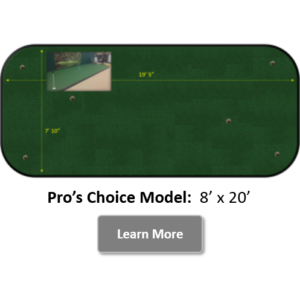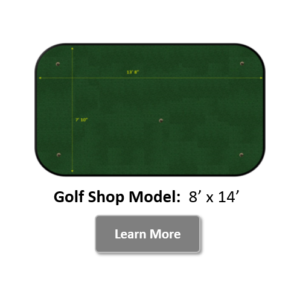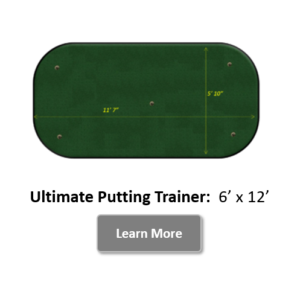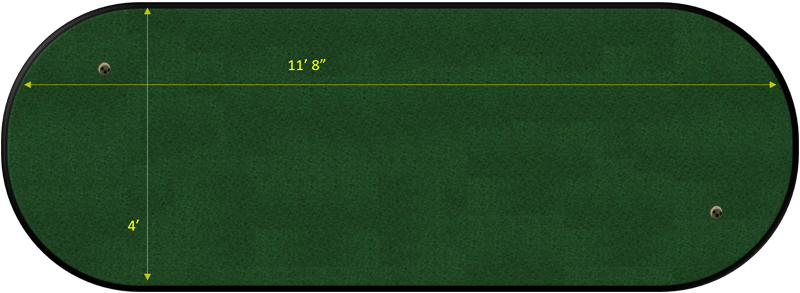Augusta National Golf Club – Augusta, Georgia
Par: 72
Total Yards: 7,435
Designer: Alister MacKenzie and Bobby Jones
While Augusta National Golf Club may look somewhat flat in the picture above, the property actually features dramatic elevation changes, the property dips over 175 feet from the clubhouse to the left of this picture down to the 12th green almost all the way to the right.

Augusta National built a new state of the art practice facility before the 2010 Masters. The facility was built on the site of an old parking lot and features a large viewing area for the fans to watch players warm up. Tour players call it the best practice area on earth.
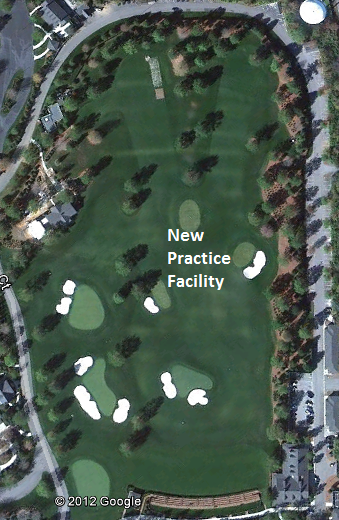
Hole Number 1: Tea Olive Par: 4 Yards: 455

Tea Olive is dog-leg right, protected by a fairway bunker and a deep green-side bunker to the left of the tricky green.
Hole Number 2: Pink Dogwood Par: 5 Yards: 575
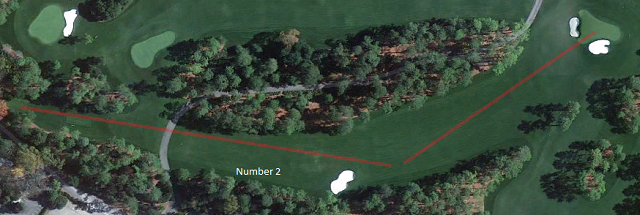
Pink Dogwood is a dog-leg left par 5 that is reachable in two for long hitters. Two large bunkers protect the green front left and front right.
Hole Number 3: Flowering Peach Par: 4 Yards: 350

Flowering Peach is a short par 4 protected by a narrow fairway and a large greenside bunker left. Alister MacKenzie believed this hole was “perfect” from a design standpoint.
Hole Number 4: Flowering Crab Apple Par: 3 Yards: 240

Flowering Crab Apple is a long par 3 requiring all carry to fly the front bunker. Missing left will result in a tough bunker shot as well.
Hole Number 5: Magnolia Par: 4 Yards: 455

Magnolia is a tough and long dogleg left. To carry the fairway bunkers requires a shot of 310+ yards. The uphill second cannot go long or it will be left in the back bunker with a tough shot, the green slopes back to front.
Hole Number 6: Juniper Par: 3 Yards: 180

Juniper is a downhill par 3 measuring 180 yards with a large bunker in front of the even larger putting green.
Hole Number 7: Pampas Par: 4 Yards: 450

Pampas is a long par 4 narrows considerably near the landing area. Trees and uneven lies make this a tough tee shot and a tougher approach. The green is protected by 5 bunkers, 3 front and 2 back.
Hole Number 8: Yellow Jasmine Par: 5 Yards: 570

This long uphill par 5 doglegs slightly to the right and is protected by a large fairway bunker right. Once you get past the fairway bunker, you need to hit a long second or lay up to this deep green protected only by mounds front, left and right.
Hole Number 9: Carolina Cherry Par: 4 Yards: 460

This moderately sharp dogleg left requires a good tee shot towards the right side of the fairway in order to avoid hitting over the deep bunkers left front of the green. The wind is a factor as your second shot uphill into a large open area. The green sits diagonal and slopes sharply from back to front.
Hole Number 10: Cammellia Par: 4 Yards: 495

Camellia is a very long par 4, dogleg left that plays slightly downhill. A large mound in the landing area will usually cause an uneven lie for your long iron second shot. The second must clear the huge fairway bunker in front of the green and stay left of the greenside bunker. Tall pines surround the green on all sides.
Hole Number 11: White Dogwood Par: 4 Yards: 505

White Dogwood is the beginning of the legendary, Amen Corner. The tee shot, which comes out of a thin wooded shoot, must be long and plays downhill to a heavily sloped fairway right to left. The right to left side-hill lie will want to pull your ball left on your long iron, into the pond. The pin will be tucked left as well, bringing the water into play. One of the most picturesque holes at Augusta.
Amen Corner
People commonly believe that “Amen Corner” consists of the 11th, 12th and 13 holes, actually Amen Corner technically only consists of the second shot on 11, the entire par 3 12th and the tee shot on 13.
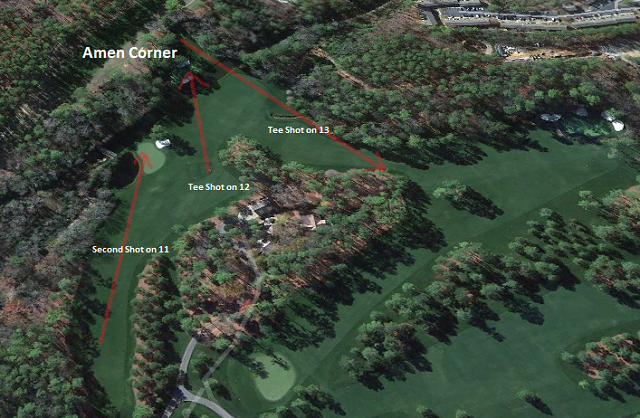
Amen corner presents multiple opportunities to blow a Major Championship.
Amen Corner Part 1 – The second shot on 11 is incredibly long and demanding but, the swirling winds are the real killer in this portion of the course. A Player must carry the water while dealing with the legendary gusting winds.
Amen Corner Part 2 – The 12th hole is a relatively short par 3 at only 155 yards and downhill. Players find the wind nearly impossible to judge, as there is a well known but difficult to understand, whirlpool effect in play. The wind comes down the hill (bottom of picture) from the clubhouse which sits nearly 180 feet higher than the 12th green.
The green on 12 sits in an enormous bowl and is the lowest point in the area, not just the property. The hill behind the hole goes up over 150 feet as well. The wind swirls so viciously, it is common for the flag on 11 to be blowing a different direction than the flag on 12, just 50 yards away.
In 1956 Bob Rosberg hit a 4-iron on 12, just as he was pulling it back, the wind changed and he hit the ball over the green, the back bunkers and the entire hill behind the green, disappearing out of bounds, less than 3 minutes later he hit the same 4-iron and put it to within 10 feet of the pin.
The wind is so tricky, the scoring average on this 155 yard par 3 is, 3.29. Not visible in the picture, the famous Hogan’s Bridge crosses over the water front left.
Amen Corner Part 3 – The tee shot on 13 is your reward for the lovely experience on 12. Lengthened numerous times, the tee shot is out of a tight shoot, set back in the tall pines. The shot must be a draw around the corner in order to avoid the tree line right. However, Rae’s Creek runs the entire length of the fairway down the left and in front of the green, which sits at the bottom of yet another gully.[/note]
Hole Number 12: Golden Bell Par: 3 Yards: 155

Golden Bell is a 155 yard, downhill par 3 that is protected by nature and design. Swirling winds make the tee shot incredibly difficult. Ben Hogan said he would wait on the tee at address until he felt the wind on his left cheek before he would strike his tee shot. Short right, water and a shaved bank. Long left is a tightly mowed collection area below the level of the green and pine bush long.
Hole Number 13: Azelea Par: 5 Yards: 510
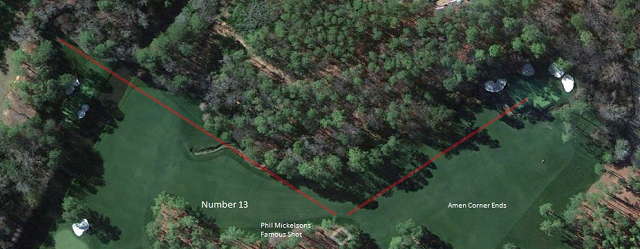
Azelea is a shortish par 5 that demands two perfect shots to go for in two. Nearly a 90 degree angle dogleg left with a sloping right to left fairway just dying to pull your ball into Rae’s Creek. The approach must carry Rae’s Creek in front of the green. Four bunkers protect the putting green from left to back right.
Phil Mickelson’s famous shot out of the pine straw in 2010 which landed on the front left portion of the green is highlighted near the bottom of the picture. Truly one of the greatest moments in modern Major Championship History.
Hole Number 14: Chinese Fur Par: 4 Yards: 440

Chinese Fur is a tough par 4 because of the sloping left to right fairway. The second shot is into a large green with a very complicated false front that is seeking to roll your second shot off the front right of the green. This is the only hole at Augusta National with No Bunkers.
Hole Number 15: Firethorn Par: 5 Yards: 530

Firethorn is a very reachable par 5. The tee shot plays uphill to a saddle shaped fairway. Once on top of the saddled fairway, your tee shot must carry the pond in front of the green. This was the hole where Gene Sarazen hit “the shot heard around the world”, a 4 wood from 235 yards for Double Eagle.
Hole Number 16: Redbud Par: 3 Yards: 170

Redbud is a scoring opportunity on the home stretch for a ball striker. The entire shot is over a pond to a green that slopes from right to left. The Sunday Pin is always tucked at the bottom of the bowled green left. A well placed tee shot shaped right to left, landing on the front left center portion of the green will funnel down to the hole and within birdie range.
In 1986, Jack Nicklaus needed a bird on 16 as he was charging, he hit a 5-iron pure and his son, who was caddying for him said: “Be right” Jack said: “It is” and it was. Jack birdied the hole, shot a back nine 30, and went on to win his sixth Green Jacket at age 46.
Hole Number 17: Nandina Par: 4 Yards: 440

Nandina plays uphill and the fairway is protected left by an enormous tree known as “The Eisenhower Tree”. President Eisenhower, an avid golfer, despised the tree so much, he asked that it be removed from the hole. In classic Augusta fashion, the club responded “Now Way” and the tree, with its low hanging branches, remains a menace to players still today.
Once you are by the tree, you will be faced with an uphill shot (where you can’t see the putting surface) to a green protected by two deep-faced bunkers, one left and one front. The green is sharply sloped back right to front left and a poorly placed ball will roll off the green between the two bunkers.
Hole Number 18: Holly Par: 4 Yards: 465

Holly is a tough, uphill dogleg right that is as visually demanding as it is physically demanding. Playing 465 yards but with the uphill terrain, it plays closer to 485 yards.
The fairway bunker left will swallow any and all balls that aren’t purely struck. The fairway is tight and tree lined with tall pines on both sides, making the possibility to cut the corner impossible.
The uphill approach shot is made even more difficult by the visual effect the deep front bunker has on the player. It obscures the entire putting surface from view. The green itself is two-tiered and a player must hit a perfect shot in order to make birdie on this world-class finishing hole.
Oh, and don’t forget to share/like on Facebook and LinkedIn below!
Augusta National Overhead Including Practice Area
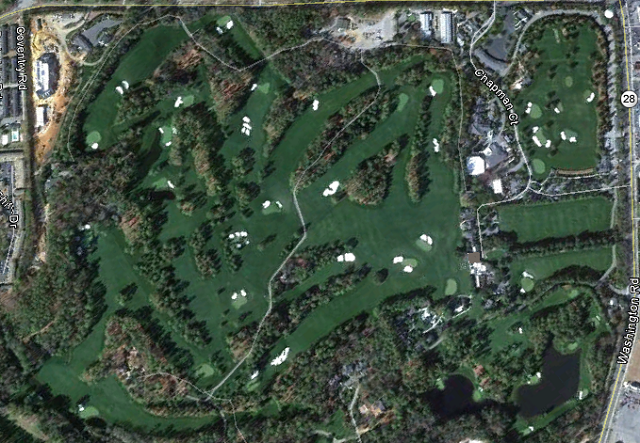

Take a moment to look over some of Jerry Kelly’s favorites from our product line.
